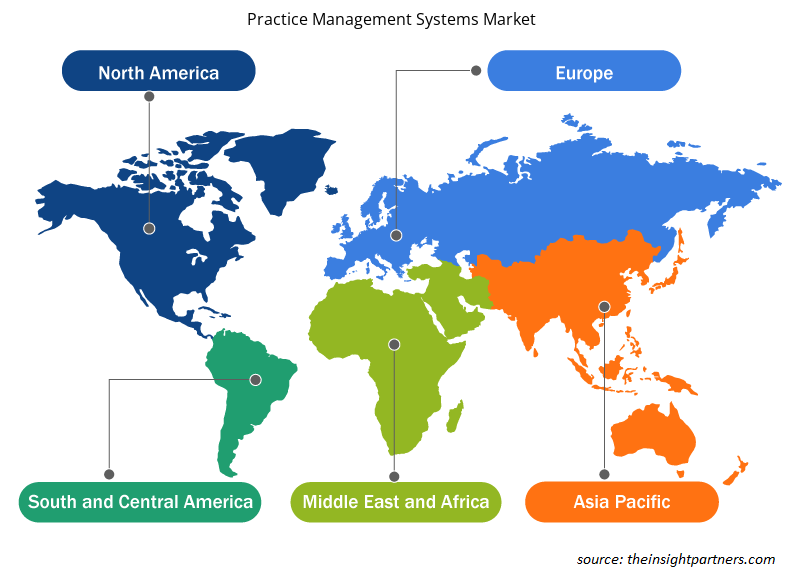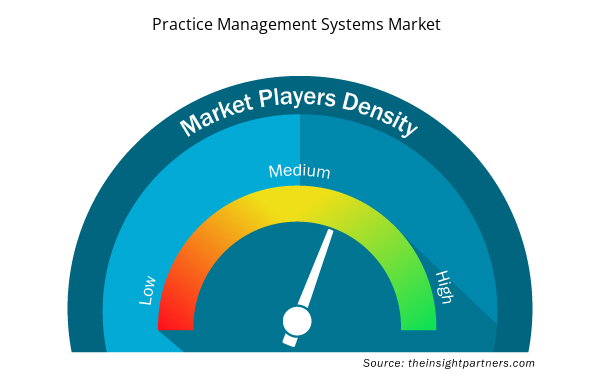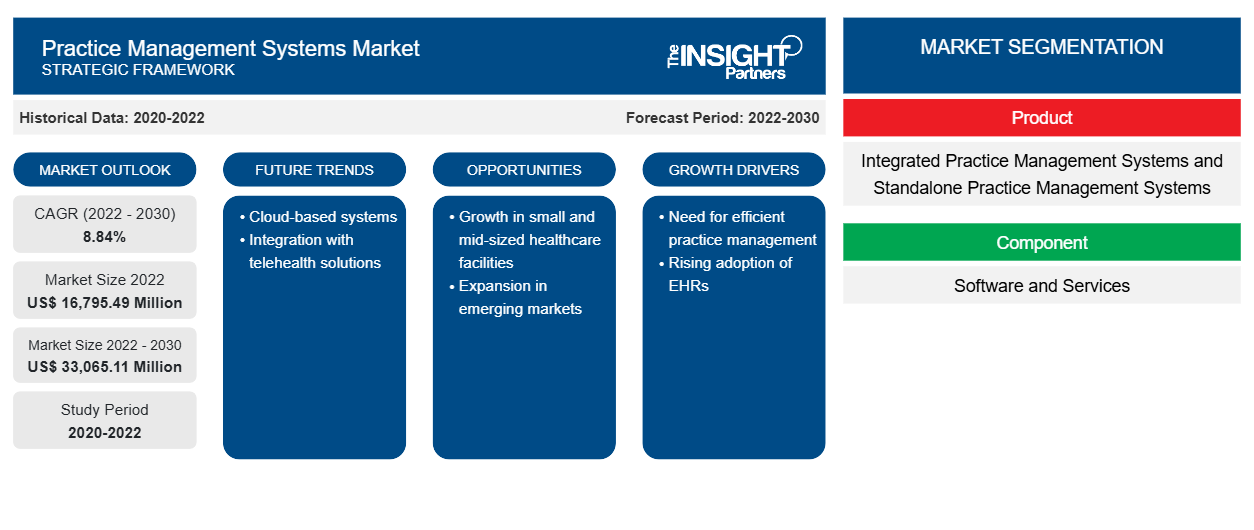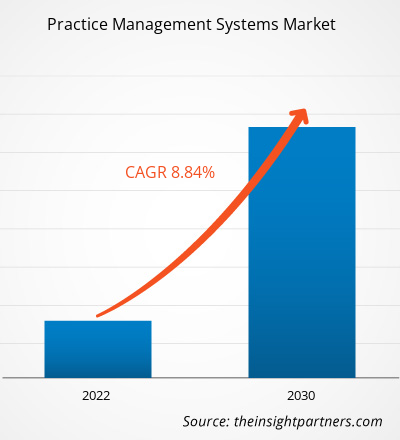Der Markt für Praxismanagementsysteme soll von 16.795,49 Millionen US-Dollar im Jahr 2022 auf 33.065,11 Millionen US-Dollar im Jahr 2030 wachsen; für den Zeitraum 2022–2030 wird eine durchschnittliche jährliche Wachstumsrate (CAGR) von 8,84 % erwartet.
Markteinblicke und Analystenansichten:
Praxismanagementlösungen ermöglichen die Koordination organisatorischer Prozesse durch verbesserte Arbeitsabläufe. Praxismanagementsysteme ermöglichen es dem Gesundheitspersonal, sich auf die Bereitstellung einer qualitativ hochwertigen Versorgung zu konzentrieren, indem sie den Verwaltungsaufwand reduzieren. Darüber hinaus automatisiert die Lösung die täglichen Patientenaktivitäten und steigert so Effizienz, Produktivität und Rentabilität. Die Lösungen helfen Ärzten auch dabei, elektronische Gesundheitsakten zu teilen und darauf zuzugreifen, wodurch die Erstellung vollständig analysierter Patientenberichte ermöglicht wird.
Wachstumstreiber:
Die Implementierung eines zuverlässigen Systems kann die Gesamteffizienz der Organisation erheblich verbessern und es dem Personal ermöglichen, sich auf die Qualität der Patientenversorgung zu konzentrieren. Durch den Einsatz eines automatisierten Praxismanagementsystems können viele sich wiederholende und redundante Aufgaben, die das Personal täglich erledigt, übernommen werden, sodass es effektiver mit den Patienten interagieren kann. Patientenmanagementsoftware spielt eine erhebliche Rolle bei der Verbesserung der Effizienz, insbesondere in Bereichen, in denen die Patientenversorgung die meiste Zeit in Anspruch nimmt. Herkömmlicherweise verlassen sich Ärzte und Patienten stark auf die Kommunikation per Telefon und E-Mail, was häufig zu längeren Wartezeiten oder verpassten Terminen aufgrund von Nichterscheinen, unterbrochenen Anrufen und Terminänderungen führt. Durch die Automatisierung der Kommunikation über das Patientenportal eines Patientenmanagementsystems kann die Patientenzufriedenheit erheblich gesteigert werden. Über dieses Portal können Patienten Termine einfach online planen, ändern oder absagen. Darüber hinaus ermöglicht ein Patientenportal die Automatisierung zahlreicher Pflegeprozesse, z. B. das Sammeln von Formularen und Umfragen, die Terminplanung, die Patientenberichterstattung und die Patientenaufklärung. Diese Automatisierung spart Zeit, steigert die Effizienz und verbessert die Qualität der Patientenversorgung. Der verbesserte Standard der Patientenversorgung treibt somit das Marktwachstum für Praxismanagementsysteme voran .
Passen Sie diesen Bericht Ihren Anforderungen an
Sie erhalten kostenlos individuelle Anpassungen an jedem Bericht, einschließlich Teilen dieses Berichts oder einer Analyse auf Länderebene, eines Excel-Datenpakets sowie tolle Angebote und Rabatte für Start-ups und Universitäten.
- Holen Sie sich die wichtigsten Markttrends aus diesem Bericht.Dieses KOSTENLOSE Beispiel umfasst eine Datenanalyse von Markttrends bis hin zu Schätzungen und Prognosen.
Berichtssegmentierung und -umfang:
Der Markt für Praxismanagementsysteme ist nach Produkt, Komponente, Bereitstellungsmodus, Anwendung, Endbenutzer und Geografie segmentiert.Basierend auf dem Produkt wird der Markt für Praxismanagementsysteme in integrierte Praxismanagementsysteme und eigenständige Praxismanagementsysteme unterteilt. Basierend auf den Komponenten wird der Markt für Praxismanagementsysteme in Software und Dienstleistungen unterteilt. Der Markt für Praxismanagementsysteme ist nach Bereitstellungsmodus in webbasierte Praxismanagementsysteme, cloudbasierte Praxismanagementsysteme und lokale Praxismanagementsysteme unterteilt. Der Markt für Praxismanagementsysteme ist nach Anwendung in Patientenaktenverfolgung, Verwaltungsaufgaben, Bearbeitung von Versicherungsansprüchen, Kodierung und Abrechnung und andere unterteilt. Basierend auf den Endbenutzern ist der Markt für Praxismanagementsysteme in Krankenhäuser und Kliniken, Arztpraxen und Labore, Versicherungsgesellschaften und andere unterteilt. Der Markt für Praxismanagementsysteme ist geografisch segmentiert in Nordamerika (USA, Kanada und Mexiko), Europa (Frankreich, Deutschland, Großbritannien, Spanien, Italien und übriges Europa), Asien-Pazifik (China, Indien, Japan, Australien, Südkorea und übriger Asien-Pazifik-Raum), Naher Osten und Afrika (Saudi-Arabien, Vereinigte Arabische Emirate, Südafrika und übriger Naher Osten und Afrika) sowie Süd- und Mittelamerika (Brasilien, Argentinien und übriges Süd- und Mittelamerika).
Segmentanalyse:
Der Markt für Praxismanagementsysteme wird nach Produkten in integrierte Praxismanagementsysteme und eigenständige Praxismanagementsysteme unterteilt. Das Segment der eigenständigen Praxismanagementsysteme hatte 2022 einen erheblichen Marktanteil und wird voraussichtlich zwischen 2022 und 2030 eine höhere durchschnittliche jährliche Wachstumsrate (CAGR) auf dem Markt verzeichnen.
Basierend auf den Komponenten ist der Markt für Praxismanagementsysteme in Software und Dienstleistungen unterteilt. Im Jahr 2022 hielt das Softwaresegment einen erheblichen Marktanteil. Es wird jedoch erwartet, dass das Dienstleistungssegment zwischen 2022 und 2030 eine höhere durchschnittliche jährliche Wachstumsrate verzeichnet.
Basierend auf der Bereitstellungsart ist der Markt für Praxismanagementsysteme in webbasierte Praxismanagementsysteme, cloudbasierte Praxismanagementsysteme und lokale Praxismanagementsysteme segmentiert. Im Jahr 2022 hielt das Segment der lokalen Praxismanagementsysteme den größten Marktanteil. Es wird jedoch erwartet, dass das Segment der cloudbasierten Praxismanagementsysteme zwischen 2022 und 2030 die höchste durchschnittliche jährliche Wachstumsrate verzeichnet.
Basierend auf der Anwendung wird der Markt für Praxismanagementsysteme in Patientenaktenverfolgung, Verwaltungsaufgaben, Bearbeitung von Versicherungsansprüchen, Kodierung und Abrechnung und andere unterteilt. Im Jahr 2022 hatte das Segment der Verwaltungsaufgaben den größten Marktanteil und wird voraussichtlich zwischen 2022 und 2030 die höchste durchschnittliche jährliche Wachstumsrate verzeichnen.
Basierend auf dem Endbenutzer ist der Markt für Praxismanagementsysteme in Krankenhäuser und Kliniken, Arztpraxen und Labore, Versicherungsunternehmen und andere unterteilt. Das Segment Krankenhäuser und Kliniken hatte 2022 den größten Marktanteil und wird voraussichtlich zwischen 2022 und 2030 die höchste durchschnittliche jährliche Wachstumsrate verzeichnen.
Regionale Analyse:
Der Markt für Praxismanagementsysteme ist in Nordamerika, Europa, Asien-Pazifik, Süd- und Mittelamerika sowie den Nahen Osten und Afrika unterteilt. Im Jahr 2022 hatte Nordamerika einen bedeutenden Marktanteil. Im Jahr 2022 hatten die USA den größten Marktanteil in der Region. Das Marktwachstum in Nordamerika ist auf die steigende Nachfrage nach einer besseren Gesundheitsinfrastruktur, die steigende Zahl geriatrischer Bevölkerungsgruppen und die starke Präsenz wichtiger Marktteilnehmer zurückzuführen. Darüber hinaus begünstigen günstige Regierungsinitiativen wie EHR-Anreizprogramme von Medicaid und Medicare das Marktwachstum. Der zunehmende Bedarf an betrieblicher Effizienz, verbesserter Dokumentation mit minimalen Fehlern und finanzieller Rentabilität für Arztpraxen treibt die Einführung von Praxismanagementsystemen voran. In den USA helfen Praxismanagementsysteme in allen Aspekten der Gesundheitskonten, Abrechnungen, Termine und Versicherungsdetails der Patienten. Die meisten US-amerikanischen Praxismanagementsoftwaresysteme sind für kleine bis mittelgroße medizinische Einrichtungen konzipiert. Einige dieser Software wird von externen medizinischen Abrechnungsfirmen für Gesundheitseinrichtungen eingesetzt. Praxismanagementsoftware wird häufig eingesetzt, um administrative und finanzielle Probleme von medizinischen Versorgungseinrichtungen und -anbietern zu lösen. Staatliche Finanzierung wird wahrscheinlich die Einführung des Praxismanagements bei Gesundheitsdienstleistern beschleunigen und die Arbeitsweise der Akteure in der gesamten Branche verändern. Daher zählen die zunehmende Einführung eines patientenzentrierten Ansatzes durch die Kostenträger im Gesundheitswesen, die Notwendigkeit, die Effizienz von Arztpraxen und -einrichtungen zu steigern, Zeit- und Ressourceneinsparungen auf lange Sicht sowie eine hohe Kapitalrendite zu den Faktoren, die das Wachstum des Marktes für Praxismanagementsysteme in Nordamerika unterstützen.
Regionale Einblicke in den Markt für Praxisverwaltungssysteme
Die regionalen Trends und Faktoren, die den Markt für Praxismanagementsysteme im Prognosezeitraum beeinflussen, wurden von den Analysten von Insight Partners ausführlich erläutert. In diesem Abschnitt werden auch Marktsegmente und Geografien für Praxismanagementsysteme in Nordamerika, Europa, im asiatisch-pazifischen Raum, im Nahen Osten und Afrika sowie in Süd- und Mittelamerika erörtert.

- Erhalten Sie regionale Daten zum Markt für Praxismanagementsysteme
Umfang des Marktberichts zu Praxismanagementsystemen
| Berichtsattribut | Details |
|---|---|
| Marktgröße im Jahr 2022 | 16.795,49 Millionen US-Dollar |
| Marktgröße bis 2030 | 33.065,11 Millionen US-Dollar |
| Globale CAGR (2022 - 2030) | 8,84 % |
| Historische Daten | 2020-2022 |
| Prognosezeitraum | 2022–2030 |
| Abgedeckte Segmente | Nach Produkt
|
| Abgedeckte Regionen und Länder | Nordamerika
|
| Marktführer und wichtige Unternehmensprofile |
|
Dichte der Marktteilnehmer für Praxismanagementsysteme: Die Auswirkungen auf die Geschäftsdynamik verstehen
Der Markt für Praxismanagementsysteme wächst rasant, angetrieben durch die steigende Nachfrage der Endnutzer aufgrund von Faktoren wie sich entwickelnden Verbraucherpräferenzen, technologischen Fortschritten und einem größeren Bewusstsein für die Vorteile des Produkts. Mit steigender Nachfrage erweitern Unternehmen ihr Angebot, entwickeln Innovationen, um die Bedürfnisse der Verbraucher zu erfüllen, und nutzen neue Trends, was das Marktwachstum weiter ankurbelt.
Die Marktteilnehmerdichte bezieht sich auf die Verteilung von Firmen oder Unternehmen, die in einem bestimmten Markt oder einer bestimmten Branche tätig sind. Sie gibt an, wie viele Wettbewerber (Marktteilnehmer) in einem bestimmten Marktraum im Verhältnis zu seiner Größe oder seinem gesamten Marktwert präsent sind.
Die wichtigsten auf dem Markt für Praxismanagementsysteme tätigen Unternehmen sind:
- WRS Gesundheit
- PraxisEHR
- Henry Schein Medical Systems Inc.
- Epic Systems Corporation
- AdvantEdge-Lösungen für das Gesundheitswesen
Haftungsausschluss : Die oben aufgeführten Unternehmen sind nicht in einer bestimmten Reihenfolge aufgeführt.

- Überblick über die wichtigsten Akteure auf dem Markt für Praxismanagementsysteme
Branchenentwicklungen und zukünftige Chancen:
Initiativen von Schlüsselakteuren inDie wichtigsten Akteure auf dem globalen Markt für Praxismanagementsysteme sind nachstehend aufgeführt:
- Im Januar 2023 brachte PatientClick, Inc. eine neue KI-gestützte Praxismanagementsoftware auf den Markt. Die neue Software bietet Automatisierung für verschiedene Aufgaben wie Terminplanung, Kreditkartenabwicklung, automatische Berechtigungsprüfungen, Patientenerinnerungen und einen Kostenschätzer. Diese Funktionen ermöglichen es dem Personal, Zahlungen über aktuelle Zahlungsgateways zu sammeln , was den Prozess effizient und rationalisiert.
- Im Mai 2021 brachte WRS Health eine neue EHR- und Praxismanagementlösung für Onkologen auf den Markt. Die Lösung ist cloudbasiert und erfüllt die Anforderungen onkologischer Praxen, einschließlich Krebsdiagnose und -behandlung.
Wettbewerbslandschaft und Schlüsselunternehmen:
WRS Health, PracticeEHR, Henry Schein Medical Systems Inc., Epic Systems Corporation, AdvantEdge Healthcare Solutions, DrChrono Inc., AdvancedMD Inc., Athenahealth, McKesson Corporation, PracticeSuite Inc. und Meditab Software Inc. gehören zu den führenden Akteuren auf dem Markt für Praxismanagementsysteme. Diese Unternehmen konzentrieren sich auf die Einführung neuer Hightech-Produkte, die Weiterentwicklung bestehender Produkte und die geografische Expansion, um der wachsenden Verbrauchernachfrage weltweit gerecht zu werden.
- Historische Analyse (2 Jahre), Basisjahr, Prognose (7 Jahre) mit CAGR
- PEST- und SWOT-Analyse
- Marktgröße Wert/Volumen – Global, Regional, Land
- Branche und Wettbewerbsumfeld
- Excel-Datensatz



Report Coverage
Revenue forecast, Company Analysis, Industry landscape, Growth factors, and Trends

Segment Covered
This text is related
to segments covered.

Regional Scope
North America, Europe, Asia Pacific, Middle East & Africa, South & Central America

Country Scope
This text is related
to country scope.
Häufig gestellte Fragen
Practice management in healthcare is the process that deals with the daily operation of medical practice. Medical practice management software helps streamline operations, produce accurate claims, and receive faster reimbursements. Practice management solutions enable coordination in organizational tasks and processes through improved workflows.
The factors driving the growth of the practice management systems market include improved patient care standards and rising pressure on healthcare institutions to provide high-quality services at reduced costs. However, issues with privacy and data security hampers the growth of the practice management systems market.
The practice management systems market majorly consists of the players, including WRS Health, PracticeEHR, Henry Schein Medical Systems Inc., Epic Systems Corporation, AdvantEdge Healthcare Solutions, DrChrono Inc., AdvancedMD Inc., Athenahealth, McKesson Corporation, PracticeSuite Inc., and Meditab Software Inc.
The practice management systems market is expected to be valued at US$ 33,065.11 million in 2030.
The global practice management systems market is segmented on the basis of product, component, delivery mode, application, and end user. The practice management systems market, by product, is categorized into integrated practice management systems and standalone practice management systems. The standalone practice management systems segment held a significant share of the market in 2022 and is expected to register a higher CAGR of 9.18% in the market during 2022–2030.
The practice management systems market was valued at US$ 16,795.49 million in 2022.
Trends and growth analysis reports related to Technology, Media and Telecommunications : READ MORE..
The List of Companies - Practice Management Systems Market
- WRS Health
- PracticeEHR
- Henry Schein Medical Systems Inc.
- Epic Systems Corporation
- AdvantEdge Healthcare Solutions
- DrChrono Inc
- AdvancedMD Inc
- Athenahealth
- McKesson Corporation
- PracticeSuite Inc
- Meditab Software Inc.
The Insight Partners performs research in 4 major stages: Data Collection & Secondary Research, Primary Research, Data Analysis and Data Triangulation & Final Review.
- Data Collection and Secondary Research:
As a market research and consulting firm operating from a decade, we have published and advised several client across the globe. First step for any study will start with an assessment of currently available data and insights from existing reports. Further, historical and current market information is collected from Investor Presentations, Annual Reports, SEC Filings, etc., and other information related to company’s performance and market positioning are gathered from Paid Databases (Factiva, Hoovers, and Reuters) and various other publications available in public domain.
Several associations trade associates, technical forums, institutes, societies and organization are accessed to gain technical as well as market related insights through their publications such as research papers, blogs and press releases related to the studies are referred to get cues about the market. Further, white papers, journals, magazines, and other news articles published in last 3 years are scrutinized and analyzed to understand the current market trends.
- Primary Research:
The primarily interview analysis comprise of data obtained from industry participants interview and answers to survey questions gathered by in-house primary team.
For primary research, interviews are conducted with industry experts/CEOs/Marketing Managers/VPs/Subject Matter Experts from both demand and supply side to get a 360-degree view of the market. The primary team conducts several interviews based on the complexity of the markets to understand the various market trends and dynamics which makes research more credible and precise.
A typical research interview fulfils the following functions:
- Provides first-hand information on the market size, market trends, growth trends, competitive landscape, and outlook
- Validates and strengthens in-house secondary research findings
- Develops the analysis team’s expertise and market understanding
Primary research involves email interactions and telephone interviews for each market, category, segment, and sub-segment across geographies. The participants who typically take part in such a process include, but are not limited to:
- Industry participants: VPs, business development managers, market intelligence managers and national sales managers
- Outside experts: Valuation experts, research analysts and key opinion leaders specializing in the electronics and semiconductor industry.
Below is the breakup of our primary respondents by company, designation, and region:

Once we receive the confirmation from primary research sources or primary respondents, we finalize the base year market estimation and forecast the data as per the macroeconomic and microeconomic factors assessed during data collection.
- Data Analysis:
Once data is validated through both secondary as well as primary respondents, we finalize the market estimations by hypothesis formulation and factor analysis at regional and country level.
- Macro-Economic Factor Analysis:
We analyse macroeconomic indicators such the gross domestic product (GDP), increase in the demand for goods and services across industries, technological advancement, regional economic growth, governmental policies, the influence of COVID-19, PEST analysis, and other aspects. This analysis aids in setting benchmarks for various nations/regions and approximating market splits. Additionally, the general trend of the aforementioned components aid in determining the market's development possibilities.
- Country Level Data:
Various factors that are especially aligned to the country are taken into account to determine the market size for a certain area and country, including the presence of vendors, such as headquarters and offices, the country's GDP, demand patterns, and industry growth. To comprehend the market dynamics for the nation, a number of growth variables, inhibitors, application areas, and current market trends are researched. The aforementioned elements aid in determining the country's overall market's growth potential.
- Company Profile:
The “Table of Contents” is formulated by listing and analyzing more than 25 - 30 companies operating in the market ecosystem across geographies. However, we profile only 10 companies as a standard practice in our syndicate reports. These 10 companies comprise leading, emerging, and regional players. Nonetheless, our analysis is not restricted to the 10 listed companies, we also analyze other companies present in the market to develop a holistic view and understand the prevailing trends. The “Company Profiles” section in the report covers key facts, business description, products & services, financial information, SWOT analysis, and key developments. The financial information presented is extracted from the annual reports and official documents of the publicly listed companies. Upon collecting the information for the sections of respective companies, we verify them via various primary sources and then compile the data in respective company profiles. The company level information helps us in deriving the base number as well as in forecasting the market size.
- Developing Base Number:
Aggregation of sales statistics (2020-2022) and macro-economic factor, and other secondary and primary research insights are utilized to arrive at base number and related market shares for 2022. The data gaps are identified in this step and relevant market data is analyzed, collected from paid primary interviews or databases. On finalizing the base year market size, forecasts are developed on the basis of macro-economic, industry and market growth factors and company level analysis.
- Data Triangulation and Final Review:
The market findings and base year market size calculations are validated from supply as well as demand side. Demand side validations are based on macro-economic factor analysis and benchmarks for respective regions and countries. In case of supply side validations, revenues of major companies are estimated (in case not available) based on industry benchmark, approximate number of employees, product portfolio, and primary interviews revenues are gathered. Further revenue from target product/service segment is assessed to avoid overshooting of market statistics. In case of heavy deviations between supply and demand side values, all thes steps are repeated to achieve synchronization.
We follow an iterative model, wherein we share our research findings with Subject Matter Experts (SME’s) and Key Opinion Leaders (KOLs) until consensus view of the market is not formulated – this model negates any drastic deviation in the opinions of experts. Only validated and universally acceptable research findings are quoted in our reports.
We have important check points that we use to validate our research findings – which we call – data triangulation, where we validate the information, we generate from secondary sources with primary interviews and then we re-validate with our internal data bases and Subject matter experts. This comprehensive model enables us to deliver high quality, reliable data in shortest possible time.


 Holen Sie sich ein kostenloses Muster für diesen Bericht
Holen Sie sich ein kostenloses Muster für diesen Bericht